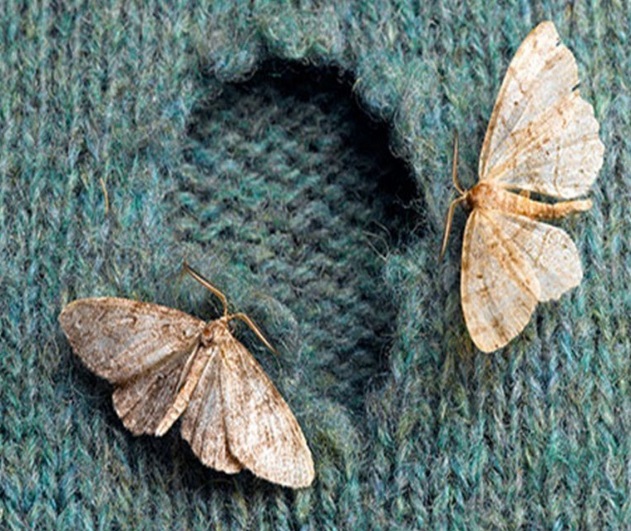Clothes Moth on:
[Wikipedia]
[Google]
[Amazon]

 Clothes moth or clothing moth is the common name for several species of
Clothes moth or clothing moth is the common name for several species of
"Clothes Moths"

 Clothes moth or clothing moth is the common name for several species of
Clothes moth or clothing moth is the common name for several species of moth
Moths are a group of insects that includes all members of the order Lepidoptera that are not Butterfly, butterflies. They were previously classified as suborder Heterocera, but the group is Paraphyly, paraphyletic with respect to butterflies (s ...
considered to be pests, whose larvae eat animal fibres (hairs), including clothing
Clothing (also known as clothes, garments, dress, apparel, or attire) is any item worn on a human human body, body. Typically, clothing is made of fabrics or textiles, but over time it has included garments made from animal skin and other thin s ...
and other fabric
Textile is an umbrella term that includes various fiber-based materials, including fibers, yarns, filaments, threads, and different types of fabric. At first, the word "textiles" only referred to woven fabrics. However, weaving is no ...
s.
These include:
* '' Tineola bisselliella'', the common clothes moth or webbing clothes moth
* '' Tinea pellionella'', the case-bearing clothes moth. Obsolete names are: ''Phalaena (Tinea) pellionella'', ''Phalaena zoolegella'', ''Tinea demiurga'', ''Tinea gerasimovi'', and ''Tinea pelliomella''
* '' Trichophaga tapetzella'', the carpet moth or tapestry moth
* '' Monopis crocicapitella'', pale-backed clothes moth. Particularly destructive of textiles, and found to have increased dramatically in south-west England in 2018.
* '' Niditinea fuscella'', the brown-dotted clothes moth
Diet and infestation
The larvae of clothes moths can eat animal fibres which are not removed by other scavengers, and are capable of consuming and digestingkeratin
Keratin () is one of a family of structural fibrous proteins also known as ''scleroproteins''. It is the key structural material making up Scale (anatomy), scales, hair, Nail (anatomy), nails, feathers, horn (anatomy), horns, claws, Hoof, hoove ...
materials that make up silk, wool, fur, and hair. This allows clothes moths to attack human-made garments and textiles which include animal fibres, damaging them and leading to the common name of these pests.Michael F. Potter"Clothes Moths"
University of Kentucky
The University of Kentucky (UK, UKY, or U of K) is a Public University, public Land-grant University, land-grant research university in Lexington, Kentucky, United States. Founded in 1865 by John Bryan Bowman as the Agricultural and Mechanical ...
College of Agriculture.
Household-wide infestations can stem from a single textile item, such as a garment or rug, with potential targets besides garments including upholstery
Upholstery is the work of providing furniture, especially seats, with padding, springs, webbing, and fabric or leather covers. The word also refers to the materials used to upholster something.
''Upholstery'' comes from the Middle English wor ...
, toys, or even taxidermied animals. Discarded fibres found around the home can contribute to infestations as well, such as pet sheddings, hair and fur buildup inside vents and air ducts, or birds' nests built inside some part of a house. Basement
A basement is any Storey, floor of a building that is not above the grade plane. Especially in residential buildings, it often is used as a utility space for a building, where such items as the Furnace (house heating), furnace, water heating, ...
s and attic
An attic (sometimes referred to as a '' loft'') is a space found directly below the pitched roof of a house or other building. It is also known as a ''sky parlor'' or a garret. Because they fill the space between the ceiling of a building's t ...
s are commonly the most heavily affected areas.Parker, Thomas A (1988). Study on integrated pest management for libraries and archives, General Information Programme and UNISIST, UNESCO
The United Nations Educational, Scientific and Cultural Organization (UNESCO ) is a List of specialized agencies of the United Nations, specialized agency of the United Nations (UN) with the aim of promoting world peace and International secur ...
. PGI.88/WS/20. https://unesdoc.unesco.org/ark:/48223/pf0000082141.locale=en Larvae can also sometimes act as bookworms, chewing through paper (which they cannot digest for nutrition) to reach book bindings or mold colonies for nourishment.
Treatment and control
Various means are used to repel or kill moths.Pheromone trap
A pheromone trap is a type of insect trap that uses pheromones to lure insects. Sex pheromones and aggregating pheromones are the most common types used. A pheromone-impregnated lure is encased in a conventional trap such as a bottle trap, delta ...
s are also used both to count and to destroy clothes moths, although these only attract certain species of clothes moth so it is possible to have an active clothes moth infestation without any moths being found on the pheromone traps. Care should be taken to correctly distinguish clothes moths from similar-appearing pantry or Indianmeal moths, so that the appropriate pheromone traps are used.
To control an infestation, all items from the area should be removed and cleaned by using a strong-suctioned vacuum, or soapy water and a washing machine to launder items in hot water for 20–30 minutes to kill eggs.
Among other methods, recommendations to protect heritage collections of textiles include checking the undersides of chairs, moving and vacuum-cleaning all furniture once a month and sealing the discarded vacuum cleaner bag, checking and shaking textiles every month, and regularly checking attics and chimneys. If textiles do become infested, adults, eggs and larvae can be killed by freezing garments in sealed bags for a fortnight (14 days).
References
{{Animal common name Insects in culture Insect common names Household pest insects